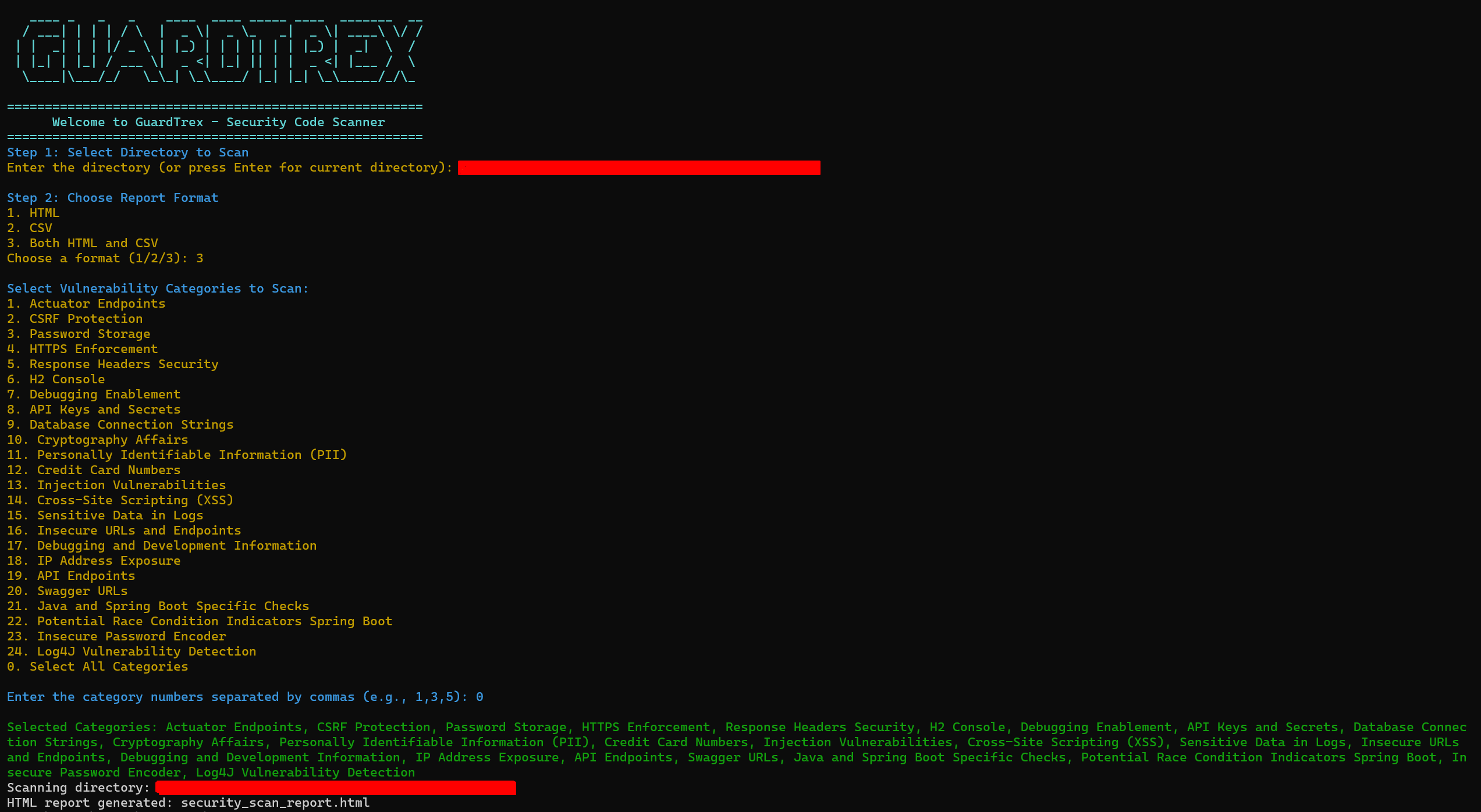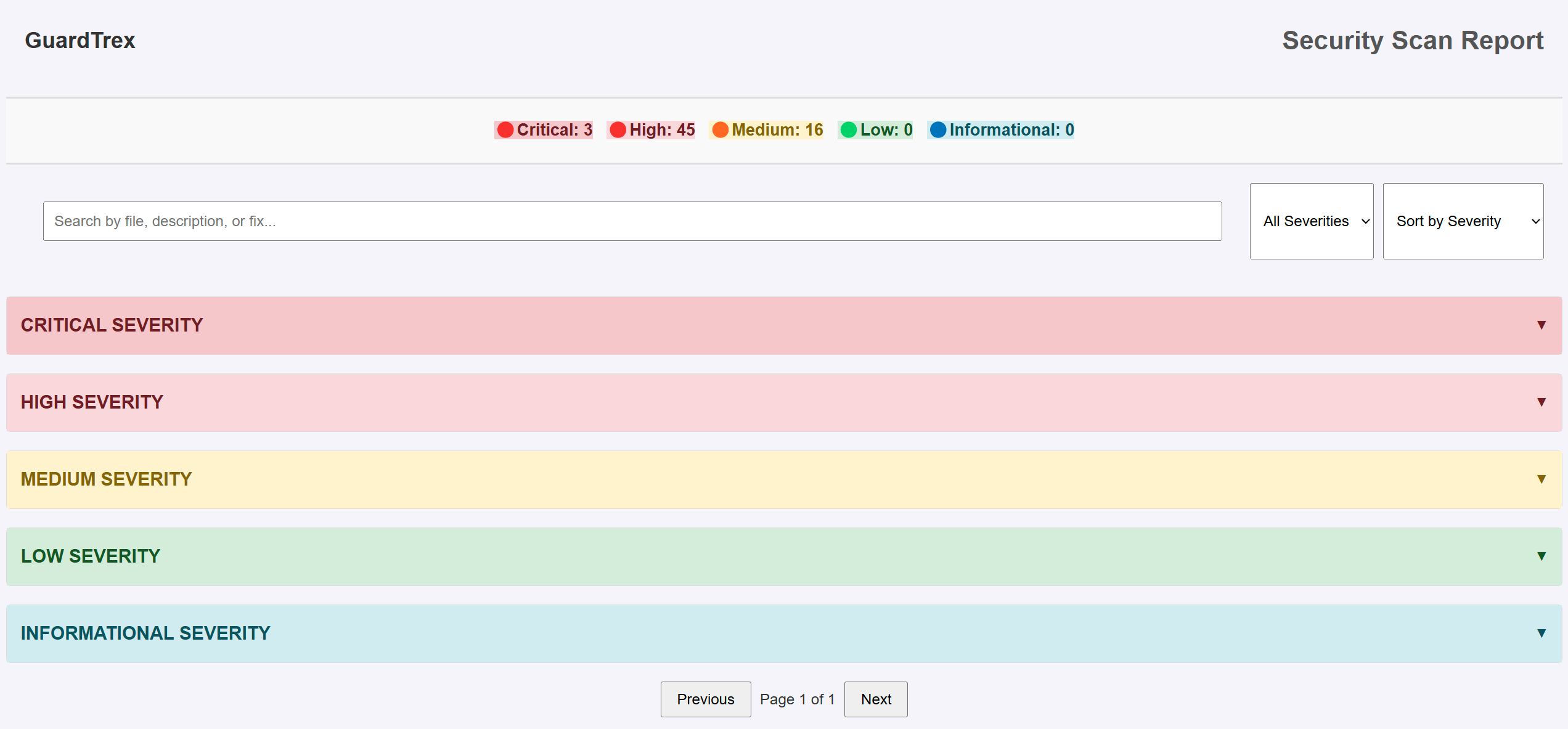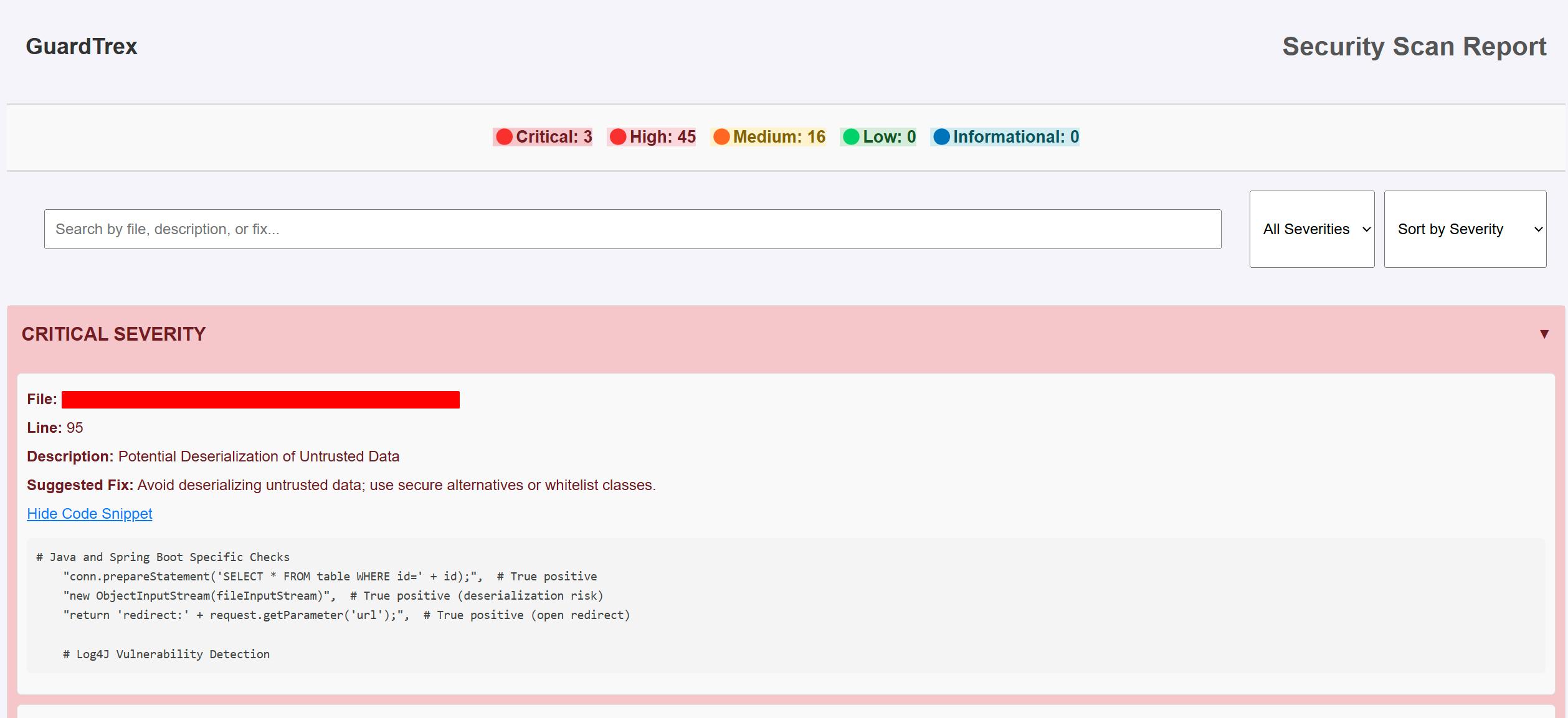GuardTrex is an advanced source code security scanner designed to identify vulnerabilities, sensitive data leaks, and insecure practices within your codebase. This tool employs custom regex-based scanning to detect common security issues across multiple file types, providing a streamlined approach to secure code management.
- Comprehensive Vulnerability Detection: Detects hardcoded credentials, API keys, insecure endpoints, and other critical security misconfigurations.
- Taint Tracking for Sensitive Data: Monitors the flow of sensitive variables, ensuring they aren’t exposed in logs or external requests.
- Incremental Scanning with File Hashing: Efficiently scans only modified files, accelerating analysis for large projects.
- Multi-File Type Compatibility: Supports various file extensions, including
.java,.properties,.xml,.py,.js,.yml, and.json. - Severity-Based Classification: Categorizes findings into severity levels (Critical, High, Medium, Low), with actionable mitigation steps.
- Flexible Report Export: Outputs findings in CSV and/or HTML formats for streamlined documentation and reporting.
- Workspace Management: Organize scan outputs, logs, and reports within a dedicated workspace folder for each run, ensuring efficient result tracking.
The Workspace feature adds a --workspace parameter, allowing you to organize scan outputs under a specified workspace name within the Workspaces/ directory. This keeps logs, caches, and reports structured by project or scan run for better traceability.
-
Clone the Repository:
git clone https://github.com/CyberDemon73/GuardTrex.git cd GuardTrex -
Install Dependencies:
pip install -r requirements.txt
Run GuardTrex with the following syntax:
python guardtrex.py <directory> --workspace <workspace_name> [--format csv|html|both]<directory>: Directory to scan.--workspace <workspace_name>: Creates a workspace folder underWorkspaces/to store all logs, caches, and reports.--format <csv|html|both>: Format of the report output. Options includecsv,html, or both.--interactive: Runs in guided mode for user-friendly setup.
This command will scan the src directory and save the output files in Workspaces/ProjectX/.
python3 guardtrex.py ./src --workspace ProjectX --format bothThe following command will give you an interactive window directly as shown below
python3 guardtrex.py --interactive --workspace ProjectXGuardTrex produces a structured report with the following details:
- File: Location of the detected issue.
- Line: Line number of the detected issue.
- Description: Explanation of the detected vulnerability.
- Severity: Classification of the issue (Critical, High, Medium, Low).
- Fix Suggestion: Recommended remediation steps.
- Code Snippet: Contextual code excerpt around the finding.
Reports are saved as security_scan_report.csv and/or security_scan_report.html in the specified workspace.
GuardTrex records all activities and errors in <workspace>/security_scan.log for comprehensive auditing and troubleshooting.
Here’s the updated Example Issues Detected section with the adjustments you've specified:
GuardTrex detects a variety of security issues that can arise in codebases, focusing on configuration errors, hardcoded secrets, sensitive data exposure, injection vulnerabilities, and more.
1. Configuration & Security Settings
- Insecure Actuator and Admin Endpoints
- Exposes all actuator endpoints, risking sensitive system information.
- Disabled CSRF Protection
- Disabling CSRF protection makes the application vulnerable to unauthorized actions.
- Missing Content Security Policy (CSP)
- Lack of CSP allows content injection attacks, such as XSS.
- TLS/SSL Disabled
- Disabling encryption exposes data in transit, making it susceptible to interception.
- Permissive CORS Policy
- Allows access from all origins, risking data leakage across domains.
- Debugging Enabled in Production
- Debug mode exposes detailed errors and internal information useful for attackers.
2. Hardcoded Secrets & Sensitive Data
- API Keys and Secrets
- Hardcoded API keys expose applications to unauthorized access.
- Database Passwords
- Storing plaintext passwords in source code poses a high risk of data exposure.
- Tokens and Session Management
- Hardcoded session IDs or JWT secrets risk account hijacking and data compromise.
3. Insecure Transmission & Endpoint Security
- Database Connection Strings
- Hardcoded database credentials can be exploited to access databases directly.
- Insecure HTTP Usage
- Transmitting data over HTTP without encryption exposes it to interception.
- Unprotected Web Services
- Exposes database consoles and other admin endpoints without protection.
4. Personally Identifiable Information (PII)
- Social Security & ID Numbers
- Detects potential SSNs or similar formats that should not be hardcoded.
- Credit Card Numbers
- Finds potential credit card numbers in code, which should be masked or securely stored.
- Sensitive Contact Details
- Hardcoded phone numbers, emails, or addresses present a privacy risk.
5. Sensitive Data in Logs & External Requests
- Logging Sensitive Data
- Logs containing sensitive data can expose this information if accessed.
- Unsecured External Transmission
- Transmitting sensitive information over untrusted sources or protocols risks exposure.
6. Injection Vulnerabilities
- Command Injection
- Command injection functions without sanitization can lead to arbitrary code execution.
- SQL Injection
- Unparameterized database queries allow attackers to inject malicious SQL.
- XXE Vulnerability
- XML external entities could be exploited to access local resources and sensitive data.
7. Deprecated Libraries & Insecure Framework Versions
- Outdated Dependency
- Detects outdated versions of libraries like OpenSSL and Log4j, which may have known vulnerabilities.
- Insecure Framework Configuration
- Allows the use of outdated protocols, increasing exposure to attacks.
8. Control Flow & Access Control Issues
- Improper Access Control Checks
- Missing role-based access control checks can lead to privilege escalation.
- Publicly Exposed APIs
- Exposes APIs without adequate access control, risking unauthorized data access.
9. Debugging & Development Configurations
- Exposed Debug Endpoints
- Debug configurations should be disabled in production for security.
- Testing URLs in Production Code
- Development or test environments should not be referenced in production.
10. IP Address & Whitelist Exposure
- Hardcoded IP Addresses
- Exposes internal or sensitive IPs, potentially revealing infrastructure layout.
- Whitelisted IP Addresses
- Hardcoding IP whitelists without dynamic configuration can compromise access control.
11. Miscellaneous Sensitive Information
- Application Secrets
- Application secrets exposed in source code pose a security risk.
- SMTP/Email Credentials
- Hardcoded email server credentials can lead to unauthorized email access.
- Authorization Headers
- Hardcoded authorization tokens risk account compromise if leaked.
GuardTrex also covers language-specific vulnerabilities that can arise from certain features and libraries used in different programming languages.
Java
- Insecure Deserialization
- Identifies risky deserialization functions that could allow arbitrary code execution.
- Hardcoded Passwords in Java Properties Files
- Detects sensitive credentials in
.propertiesfiles commonly used in Java projects.
- Detects sensitive credentials in
- Reflection and Dynamic Code Execution
- Finds instances of dynamic code execution that may be exploitable if not secured.
Python
- Pickle Insecure Deserialization
- Detects the use of
pickleand other insecure serialization modules.
- Detects the use of
- Flask Debug Mode Enabled
- Identifies instances of Flask applications running in debug mode, which should be disabled in production.
- Hardcoded API Keys in
.envFiles- Finds sensitive information in configuration files like
.env.
- Finds sensitive information in configuration files like
JavaScript/Node.js
- Insecure
evalUsage- Finds instances of
eval,Functionconstructors, and similar patterns that allow arbitrary code execution.
- Finds instances of
- Hardcoded JWT Secrets
- Detects hardcoded secrets used for JWT, which should be securely stored and dynamically configured.
- Improper CORS Configuration
- Identifies overly permissive CORS settings, especially in Express.js applications.
Ruby
- Insecure YAML Deserialization
- Detects YAML deserialization functions, which can be vulnerable to remote code execution if not properly handled.
- Rails
strong_parametersMisconfiguration- Finds Rails applications with improperly configured strong parameters, potentially allowing mass assignment vulnerabilities.
- Secrets in Rails Configuration Files
- Checks for sensitive keys in
secrets.ymlorcredentials.yml.enc, which should be protected.
- Checks for sensitive keys in
PHP
- Insecure SQL Queries
- Finds SQL queries that concatenate user inputs, increasing SQL injection risks.
- Insecure File Uploads
- Detects patterns for file uploads that lack proper validation, allowing malicious file types.
- Deprecated Function Usage
- Identifies usage of deprecated or insecure PHP functions, such as
mysql_queryorcreate_function.
- Identifies usage of deprecated or insecure PHP functions, such as
.NET
- Hardcoded Connection Strings
- Detects connection strings hardcoded in
.configfiles, which should be secured.
- Detects connection strings hardcoded in
- Insecure ViewState
- Checks for improperly configured
ViewState, which can lead to tampering vulnerabilities.
- Checks for improperly configured
- Weak Authentication Schemes
- Identifies weak or outdated authentication schemes within ASP.NET applications.
Contributions are welcome. To add new patterns or improve functionality, submit a pull request.
This project is licensed under the MIT License.



